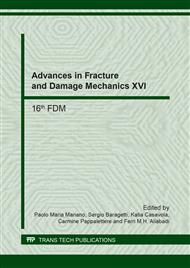p.291
p.295
p.299
p.303
p.309
p.313
p.317
p.321
p.325
Damage-Involved Structural Pounding in Bridges under Seismic Excitation
Abstract:
During severe earthquakes, pounding between adjacent superstructure segments of highway elevated bridges was often observed. It is usually caused by the seismic wave propagation effect and may lead to significant damage. The aim of the present paper is to show the results of the numerical analysis focused on damage-involved pounding between neighbouring decks of an elevated bridge under seismic excitation. The analysis was carried out using a lumped mass structural model with every deck element discretized as a SDOF system. Pounding was simulated by the use of impact elements which become active when contact is detected. The linear viscoelastic model of collision was applied allowing for dissipation of energy due to damage at the contact points of colliding deck elements. The results show that pounding may substantially modify the behaviour of the analysed elevated bridge. It may increase the structural response or play a positive role, and the response depends on pattern of collisions between deck elements. The results also indicate that a number of impacts for a small in-between gap size is large, whereas the value of peak pounding force is low. On the other hand, the pounding force time history for large gap values shows only a few collisions, but the value of peak pounding force is substantially large, what may intensify structural damage.
Info:
Periodical:
Pages:
309-312
Citation:
Online since:
September 2017
Authors:
Keywords:
Price:
Сopyright:
© 2017 Trans Tech Publications Ltd. All Rights Reserved
Share:
Citation:


